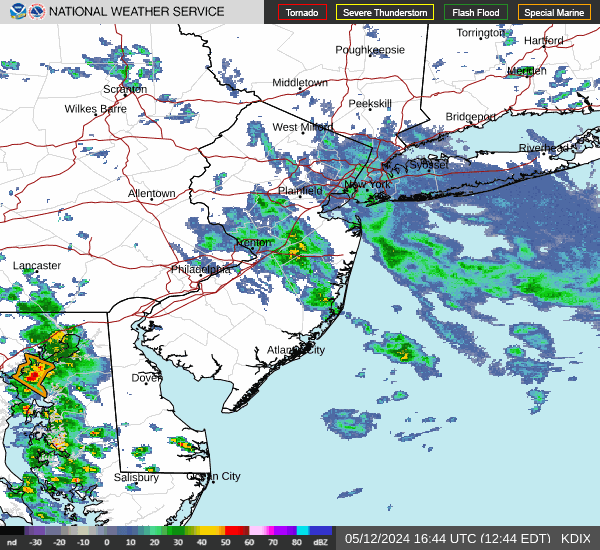The New York Times, July 29, 1945:
B-25 CRASHES IN FOGHole 18 by 20 Feet Torn Through North Wall by Terrific Impact
by Frank Adams
A twin-engined B-25 Army bomber, lost in a blinding fog, crashed into the Empire State Building at a point 915 feet above the street level at 9:49 A.M. yesterday. Thirteen persons, including the three occupants of the plane and ten persons at work within the building, were killed in the catastrophe, and twenty-six were injured.
Although the crash and the fire that followed wrecked most of the seventy-eighth and seventy-ninth floors of the structure, causing damage estimated at $500,000, Lieut. Gen. Hugh A. Drum, president of the Empire State, Inc., Corporation, said last night that an inspection by the city's building department and by other engineers and architects showed that the structural soundness of the building had not been impaired.
Landing Advice Disregarded
The plane, en route from Bedford, Mass., to Newark on a cross-country mission, had flown over LaGuardia Field a few minutes before the crash, and its pilot, Lieut. Col. William F. Smith Jr., deputy commander of the 457th Bomber Group and recently decorated for his service overseas, was advised by the control tower to land. Instead he asked for the weather at Newark Airport and headed in that direction.
Horror-stricken occupants of the building, alarmed by the roar of engines, ran to the windows just in time to see the plane loom out of the gray mists that swathed the world's tallest office building. The plane was banked at an angle of about fifteen degrees as Colonel Smith swung it in a curve out of the northeast.
It crashed with a terrifying impact midway along the north or Thirty-fourth Street wall of the building. Its wings were sheared off by the impact, but the motors and fuselage ripped a hole eighteen feet wide and twenty feet high in the outer wall of the seventy-eighth and seventy-ninth floors of the structure.
Brilliant orange flames shot as high as the observatory on the eighty-sixth floor of the building, 1,050 feet above Fifth Avenue, as the gasoline tanks of the plane exploded...
Motor Hits Another Building
One of the plane's two motors hurtled clear across the seventy-eighth floor, tore a hole in the south wall of the building, and plummeted to the roof of the twelve-story office building at 10 West Thirty-third Street, where it started a fire that demolished the penthouse of Henry Hering, noted sculptor, with resulting damage estimated at $75,000.
A propeller was imbedded in the wall of the Empire State Building; the other motor and part of the landing gear crashed into an elevator shaft, where they fell to the sub-cellar 1,000 feet below, and other sections of the fuselage were blown as high as the eighty-sixth floor observatory. The steel girder at the seventy-ninth floor level was bent inward eighteen inches by the shock.
Cascading torrents of flaming gasoline poured through the seventy-eighth and seventy-ninth floors, setting fire to everything that was combustible. The burning fuel ran down stair wells into hallways as far as the seventy-fifty floor, while choking fumes and smoke rose upward to the observatory.
Between fifteen and twenty persons, most of them girl clerical workers, were at their desks in the offices of the War Relief Service of the National Catholic Welfare Conference, occupying the southwest section of the seventy-ninth floor, when the flaming flood burst in upon them.
Most of them ran in terror for the doors. At least four of them... safely reached the haven of the fireproof stair well, but several were overtaken by the flames as they ran and were burned to death...
Paul Dearing... saw the flames approaching his desk near the west wall of the building, and jumped from a nearby window. He struck a ledge outside the seventy-second floor and was killed...
3 Occupants of Plane Perish
The bodies of the three occupants of the plane were hurled into the fiery inferno on the seventy-ninth floor, where, like those of the girl employees who were trapped there, they were burned beyond recognition...
Most of those injured were on the upper floors of the building, but in a few cases persons walking along the sidewalks below suffered minor injuries from falling debris. It was considered astonishing, in view of the amount of broken glass and other debris that showered down, that these injuries were not more numerous and more serious.
Hundreds, if not thousands, of persons along Fifth Avenue and the near-by side streets saw the crash, and police headquarters was deluged almost immediately with calls from persons who wished to give the alarm...
The shock was felt for blocks around Fifth Avenue and Thirty-fourth Street, and the explosion was heard more than a mile. Debris was thrown as far away as Madison Avenue...
Within eight minutes four alarms were sounded, bringing twenty-three fire companies and forty-one pieces of apparatus to the scene...
The flames were put out within forty minutes...
|
